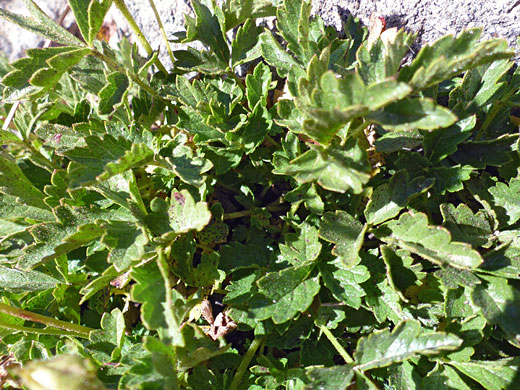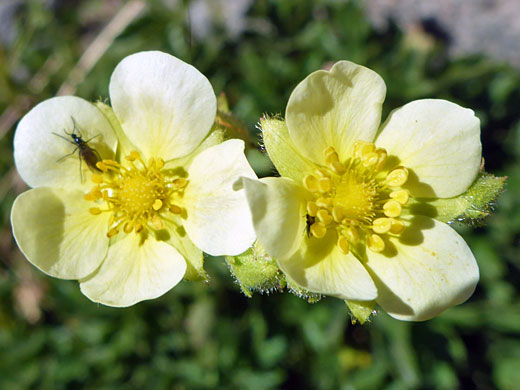Drymocallis Pseudorupestris, Cliff Woodbeauty
Plants > Wildflowers > Rosaceae > Drymocallis Pseudorupestris

Flower and bud of drymocallis pseudorupestris, Sepulcher Mountain Trail, Yellowstone National Park, Wyoming
Common name:
Cliff woodbeauty
Family:
Scientific name:
Drymocallis pseudorupestris
Main flower color:
Range:
Mostly in the Pacific states and the northern Rocky Mountains
Height:
Up to 16 inches
Habitat:
Talus slopes, ledges, rocky outcrops; from 3,500 to 12,500 feet
Leaves:
Up to 6 inches long, compound; divided into a terminal leaflet and 2 to 5 pairs of side leaflets, all toothed
Season:
June to August
Drymocallis pseudorupestris is most often round in rocky places at medium to high elevations, forming low clumps of overlapping, branched, leafy stems from which rise slender stalks toped by white or pale yellow flowers. Stems are densely covered by glandular hairs, which are branched towards their tips. Leaves are usually glabrous though can also be hairy, sometimes densely. Leaves are divided into an obovate terminal leaflet and 2 to 5 (usually 3 or 4) pairs of lateral leaflets. The leaflets are lined by up to 15 teeth, generally single rather than double. Basal leaves, if present, number just one or two, and have two or three pairs of side leaflets, reduced in size.
The flowers are borne on stalks of up to one inch, glandular and hairy. Flowers are formed of five green sepals, hairy underneath, and five obovate petals, touching or slightly overlapping. Petals are a little longer than the sepals. The flower center contains a ring of yellow stamens around a group of small carpels.
There are three varieties of drymocallis pseudorupestris (crumiana, pseudorupestris, saxicola), differentiated by hairiness and leaf characteristics.
The flowers are borne on stalks of up to one inch, glandular and hairy. Flowers are formed of five green sepals, hairy underneath, and five obovate petals, touching or slightly overlapping. Petals are a little longer than the sepals. The flower center contains a ring of yellow stamens around a group of small carpels.
There are three varieties of drymocallis pseudorupestris (crumiana, pseudorupestris, saxicola), differentiated by hairiness and leaf characteristics.
All Contents © Copyright The American Southwest | Comments and Questions | Contribute | Site Map


